Sep 28, 2020
Following long-awaited observation of ultra-peculiar source, the "bursting pulsar", GRO J1744-28 with XMM-Newton in quiescence, we finally published a work reporting on the results.

We detected the source at a luminosity level of $\sim10^{34}$erg/s with an
X-ray spectrum that is consistent with the power law, blackbody, or
accretion-heated neutron star atmosphere models. The improved X-ray
localization of the source allowed us to confirm the previously identified
candidate optical counterpart as a relatively massive G/K~III star at 8 kpc
close to the Galactic center, implying an almost face-on view of the binary
system. Although we could only find a nonrestricting upper limit on the pulsed
fraction of ∼20%, the observed hard X-ray spectrum and strong long-term
variability of the X-ray flux suggest that the source is also still accreting
when not in outburst. The luminosity corresponding to the onset of centrifugal
inhibition of accretion is thus estimated to be at least two orders of
magnitude lower than previously reported. We discuss this finding in the
context of previous studies and argue that the results indicate a multipole
structure in the magnetic field with the first dipole term of ∼1010 G, which is
much lower than previously assumed.
Sep 12, 2020
Now finally out of the embargo! The detailed press-release is available at our webpage, but
I must also briefly summarize it here: basically eRosita has just found gigantic "bubbles" encompassing famous Fermi Bubbles, so even larger than those!
In eRosita all-sky survey they look like that
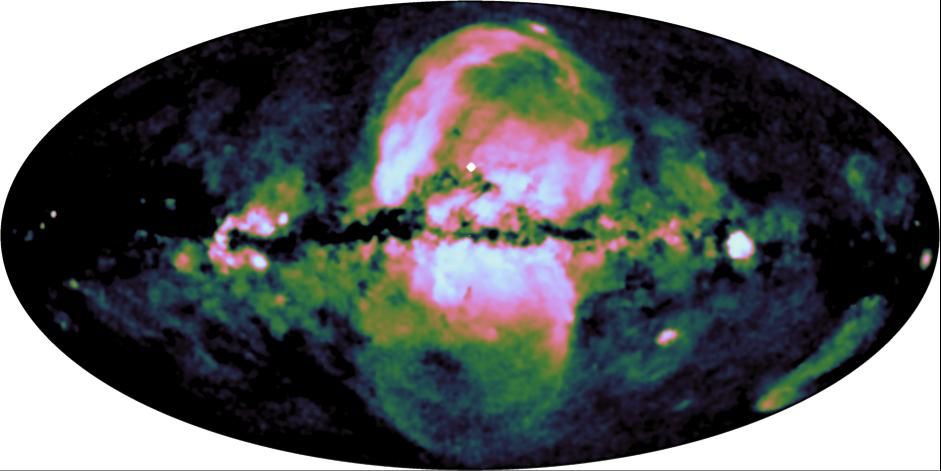
Here the false-color map the extended emission at energies of 0.6-1.0 keV
highlights the structure extending from teh Galactic center upwards and
downwards. The upper part was actually already known in X-rays as a North Polar Spur (NPS), but it was believed to be a local structure associated with an old SNR or somethign similar.
Now it became clear that NPS together with the newly seen part form structure analogous to Fermi bubbles, which we called eRosita bubbles.
That thing is huge and required huge amount of energy to blow! The source of energy is still uncertain, so lots to be done in the near future.
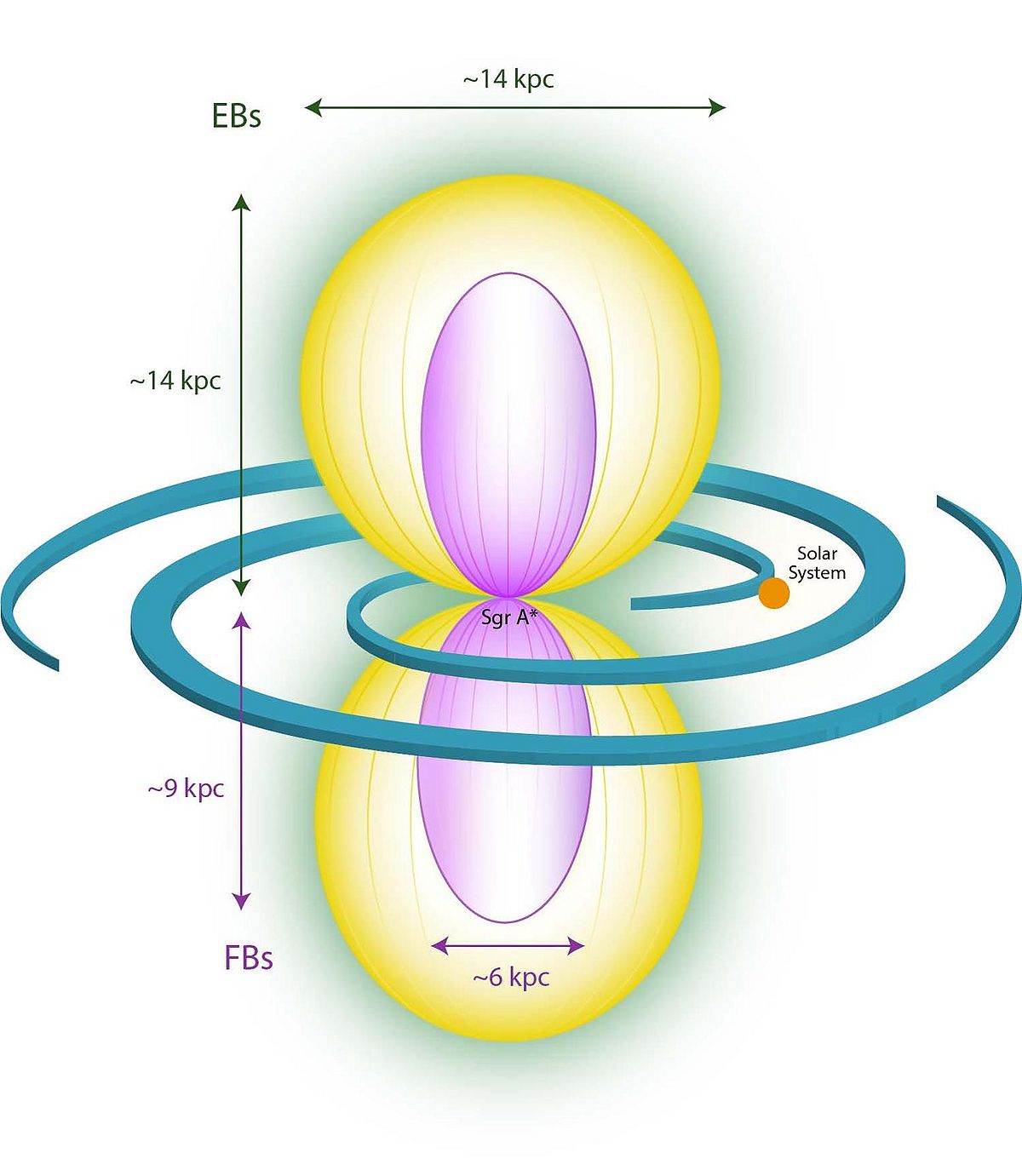
Schematic view of the eROSITA (yellow) and Fermi bubbles (purple). The galactic
disk is indicated with its spiral arms and the location of the Solar System is
marked. The eROSITA bubbles are considerably larger than the Fermi bubbles,
indicating that these structures are comparable in size to the whole galaxy.
As you could imagine, we went to Nature to publish this discovery.
From my side, I'd like to add that the latest touches to the images now published were prepared in August, just before we went off to vacations in Italy.
Basically, I were running circles between the laptop and stuff scattered all around the house and partly in the car already! Now it has payed off, which I'm really happy about.
PS. Vacation was nice too!
Sep 07, 2020
We've just published a large review on
HMXBs. Large
team of authors led by Peter Kretschmar who managed to find time to do that
somehow!
High mass X-ray binaries are among the brightest X-ray sources in the Milky
Way, as well as in nearby Galaxies. Thanks to their highly variable emissions
and complex phenomenology, they have attracted the interest of the high energy
astrophysical community since the dawn of X-ray Astronomy. In more recent
years, they have challenged our comprehension of physical processes in many
more energy bands, ranging from the infrared to very high energies. In this
review, we provide a broad but concise summary of the physical processes
dominating the emission from high mass X-ray binaries across virtually the
whole electromagnetic spectrum. These comprise the interaction of stellar winds
with the high gravitational and magnetic fields of compact objects, the
behaviour of matter under extreme magnetic and gravity conditions, and the
perturbation of the massive star evolutionary processes by presence in a binary
system. We highlight the role of the INTEGRAL mission in the discovery of many
of the most interesting objects in the high mass X-ray binary class and its
contribution in reviving the interest for these sources over the past two
decades. We show how the INTEGRAL discoveries have not only contributed to
significantly increase the number of high mass X-ray binaries known, thus
advancing our understanding of the population as a whole, but also have opened
new windows of investigation that stimulated the multi-wavelength approach
nowadays common in most astrophysical research fields. We conclude the review
by providing an overview of future facilities being planned from the X-ray to
the very high energy domain that will hopefully help us in finding an answer to
the many questions left open after more than 18 years of INTEGRAL scientific
observations.
Aug 24, 2020
After a long while and lots of work by Alexander Lutovinov, Valery Suleimanov and others (including my modest contribution),
a gigantic review on CVs and Symbiotic binaries is finally published.
Accreting white dwarfs (WDs) constitute a significant fraction of the hard
X-ray sources detected by the INTEGRAL observatory. Most of them are magnetic
Cataclysmic Variables (CVs) of the intermediate polar (IP) and polar types, but
the contribution of the Nova-likes systems and the systems with optically thin
boundary layers, Dwarf Novae (DNs) and Symbiotic Binaries (or Symbiotic Stars,
SySs) in quiescence is also not negligible. Here we present a short review of
the results obtained from the observations of cataclysmic variables and
symbiotic binaries by INTEGRAL. The highlight results include the significant
increase of the known IP population, determination of the WD mass for a
significant fraction of IPs, the establishment of the luminosity function of
magnetic CVs, and uncovering origin of the Galactic ridge X-ray emission which
appears to largely be associated with hard emission from magnetic CVs.
Aug 21, 2020
A follow-up of our work with Valery Suleimanov on IPs has just been published.
This time led by our US collegues (Thanks Aarran!).
NuSTAR is a wonderful instrument, and much better than BAT when doing precise measurements for fainter objects!
This allowed to correct couple of outliers we've got in earlier work with Valery Suleimanov, and overall, improve
accuracy for mass measurements.
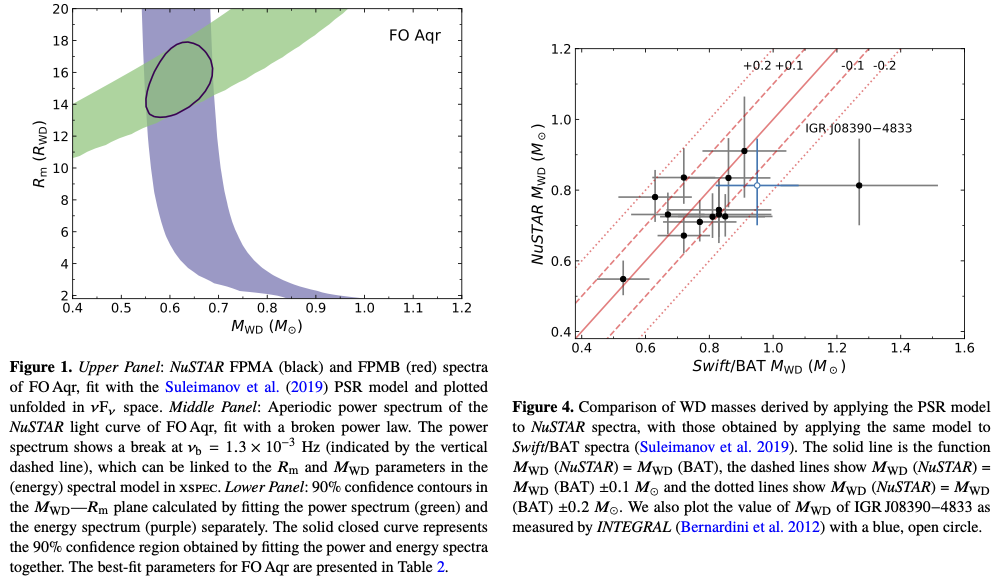
The hard X-ray spectrum of magnetic cataclysmic variables can be modelled to
provide a measurement of white dwarf mass. This method is complementary to
radial velocity measurements, which depend on the (typically rather uncertain)
binary inclination. Here we present results from a Legacy Survey of 19 magnetic
cataclysmic variables with NuSTAR. We fit accretion column models to their
20-78 keV spectra and derive the white dwarf masses, finding a weighted average
M${WD}$=0.77$\pm0.02M\odot$, with a standard deviation $\sigma=0.1M_\odot$, when we include the
masses derived from previous NuSTAR observations of seven additional magnetic
cataclysmic variables. We find that the mass distribution of accreting magnetic
white dwarfs is consistent with that of white dwarfs in non-magnetic
cataclysmic variables. Both peak at a higher mass than the distributions of
isolated white dwarfs and post-common-envelope binaries. We speculate as to why
this might be the case, proposing that consequential angular momentum losses
may play a role in accreting magnetic white dwarfs and/or that our knowledge of
how the white dwarf mass changes over accretion-nova cycles may also be
incomplete.
Aug 04, 2020
A nice Insight-HXMT result was just published by our Chinese friends (but we're also involved).
Large effective area of HE detector makes such things possible!
We report on the observation of the accreting pulsar GRO J1008-57 performed by
Insight-HXMT at the peak of the source's 2017 outburst. Pulsations are detected
with a spin period of 93.283(1) s. The pulse profile shows double peaks at soft
X-rays, and only one peak above 20 keV. The spectrum is well described by the
phenomenological models of X-ray pulsars. A cyclotron resonant scattering
feature is detected with very high statistical significance at a centroid
energy of E${cyc}$=90.32$^{+0.32}$$ keV, for the reference continuum and line
models, HIGHECUT and GABS respectively. Detection is very robust with respect
to different continuum models. The line energy is significantly higher than
what suggested from previous observations, which provided very marginal
evidence for the line. This establishes a new record for the centroid energy of
a fundamental cyclotron resonant scattering feature observed in accreting
pulsars. We also discuss the accretion regime of the source during the
Insight-HXMT observation.
Apr 01, 2020
The mission works as intended and constantly gives new results! Several ATELS on pulsars in magellanic clouds have just been posted.
eRASSU J052914.9-662446: SRG/eROSITA discovery of a second Be/X-ray binary in the LMC
X-ray pulsations from the recently discovered Be/X-ray binary eRASSU J052914.9-662446 in the LMC
eRASSU J050810.4-660653: SRG/eROSITA discovery of a new Be/X-ray binary in the LMC
SRG/eROSITA observations of a bright X-ray outburst from Circinus X-1
SRG/eROSITA discovery of a bright supersoft X-ray emission from the classical nova AT 2018bej in the Large Magellanic Cloud
Apr 01, 2020
The first author is Doroshenko, but it's not me. My wife just published a paper
containing an interesting discussion regarding modeling of broadband continuum in X-ray pulsars and re-analysis of old BeppoSAX data.
Motivated by the alleged detection of a cyclotron resonance scattering feature
in the X-ray spectrum of the Be-transient KS 1947+300 with NuSTAR, not observed
with other observatories, we have revisited the available observations of the
source to clarify the origin of the reported feature. We focus on the analysis
of observations obtained with the BeppoSAX observatory during the 2001
outburst, and by NuSTAR in 2013, when the discovery of the line was reported.
We find that in both cases, the source broad-band X-ray continuum can be well
described with a two-component Comptonization model, which does not require an
additional absorption-like feature. In addition, we show that low-significance
residuals mimicking the line, which appear using different continuum models,
are consistent with known calibration uncertainties. We therefore conclude that
the reported cyclotron line detection is largely questionable, and thus the
question on the strength of the source magnetic field remains open. We briefly
discuss the origin of the observed broad-band continuum in the context of the
pulse-phase-resolved analysis conducted for BeppoSAX data and speculate that
the soft component may be associated with the emission from polar areas of the
pulsar irradiated by the accretion column.
Mar 31, 2020
A flashback from my PhD times... I've seen this wiggle long ago but did not understand what it means.
Now Juhani Mönkkönen finally noticed it again, and after some time we've come up with an interesting interpretation.
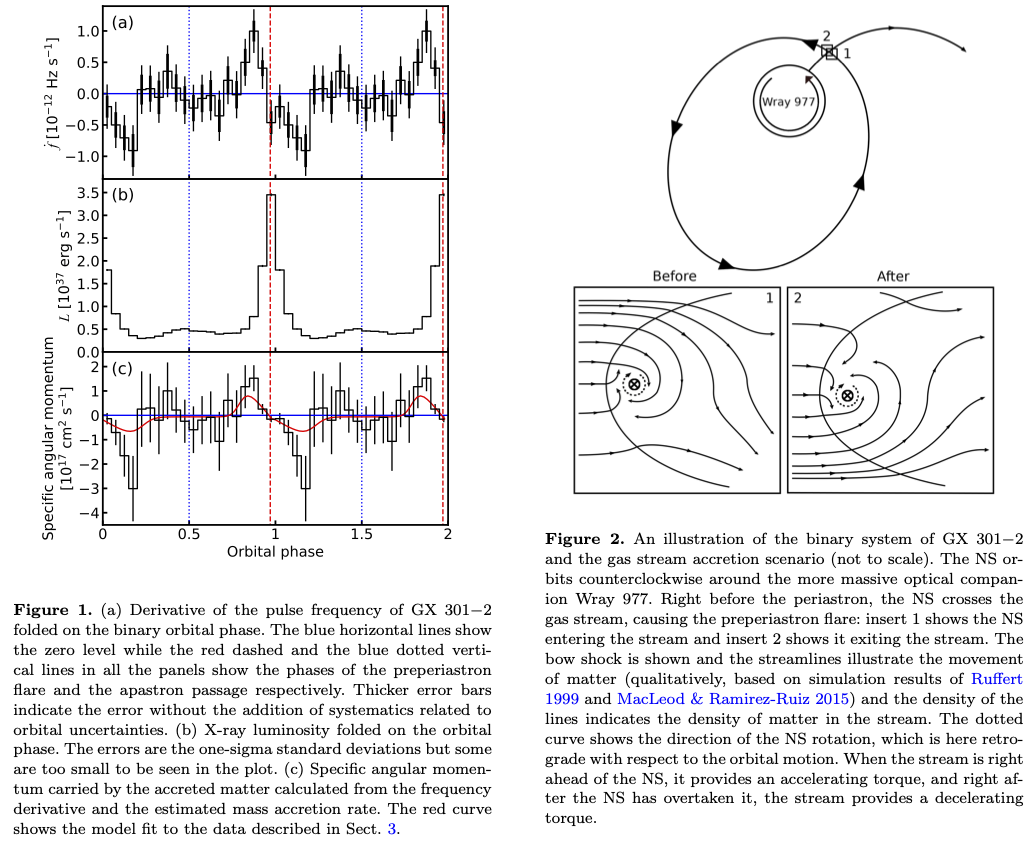
We report on the analysis of the spin evolution of a slow X-ray pulsar GX 301-2
along the orbit using long-term monitoring by Fermi/Gamma-ray Burst Monitor.
Based on the observationally confirmed accretion scenario and an analytical
model for the accretion of angular momentum, we demonstrate that in this
system, the neutron star spins retrogradely, that is, in a direction opposite
to the orbital motion. This first-of-a-kind discovery of such a system proves
the principal possibility of retrograde rotation in accreting systems with
suitable accretion torque, and might have profound consequences for our
understanding of the spin evolution of X-ray pulsars, estimates of their
initial spin periods, and the ultimate result of their evolution.
Nov 04, 2019
My quickest paper to date (4 days to submission). Still, some interesting results are reported!
The hard X-ray transient source Swift J1845.7-0037 was discovered in 2012 by
Swift/BAT. However, at that time no dedicated observations of the source were
performed. On Oct 2019 the source became active again, and X-ray pulsations
with a period of ~199s were detected with Swift/XRT. This triggered follow-up
observations with NuSTAR. Here we report on the timing and spectral analysis of
the source properties using NuSTAR and Swift/XRT. The main goal was to confirm
pulsations and search for possible cyclotron lines in the broadband spectrum of
the source to probe its magnetic field. Despite highly significant pulsations
with period of 207.379(2) were detected, no evidence for a cyclotron line was
found in the spectrum of the source. We therefore discuss the strength of the
magnetic field based on the source flux and the detection of the transition to
the "cold-disc" accretion regime during the 2012 outburst. Our conclusion is
that, most likely, the source is a highly magnetized neutron star with B 10$^{13}$G
at a large distance of d~10 kpc. The latter one consistent with the
non-detection of a cyclotron line in the NuSTAR energy band.
Sep 27, 2019
Who said magnetized neutron stars can not have super-critical disks?
In recent paper we show that this can well be when the accretion rate is high enough $\ge10^{19}$g/s.
Such rates are hard to achieve, but when done, result is spectacular!
We report on analysis of observations of the bright transient X-ray pulsar
(XRP) Swift J0243.6+6124 obtained during its 2017-2018 giant outburst with
Insight-HXMT, NuSTAR, and Swift observatories. We focus on the discovery of a
sharp state transition of the timing and spectral properties of the source at
super-Eddington accretion rates, which we associate with the transition of the
accretion disc to a radiation pressure dominated state, the first ever directly
observed for magnetized neutron star. This transition occurs at slightly higher
luminosity compared to already reported transition of the source from sub- to
supercritical accretion regime associate with onset of an accretion column. We
argue that this scenario can only be realized for comparatively weakly
magnetized neutron star, not dissimilar to other ultra-luminous X-ray pulsars,
which accrete at similar rates. Further evidence for this conclusion is
provided by the non-detection of the transition to the propeller state in
quiescence which strongly implies compact magnetosphere and thus rules out
magnetar-like fields.
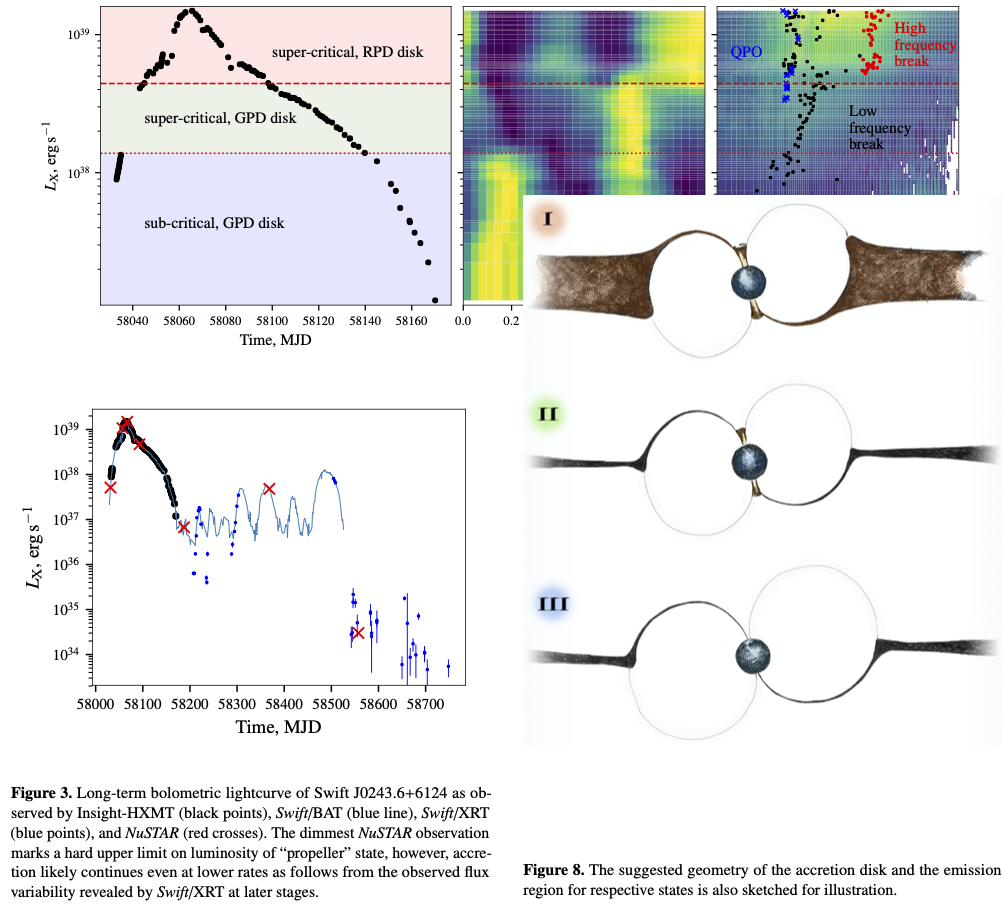
Several recors here: brightest Galactic X-ray pulsar, faintest Galactic X-ray pulsar,
first Galactic ultra-luminous pulsar, best studied ultra-luminous X-ray source :)
Jul 30, 2019
Armin has spent some time in Tuebingen this year, and myself in Turku,
and here's one of the results in
collaboration also with Moscow collegues. Great work Armin!
We report on NuSTAR observations of the well-known wind-accreting
X-ray pulsar \source\ during a strong spin-up episode that took place in
January-March 2019. A high luminosity of the source in a most recent
observation allowed us to detect a positive correlation of the cyclotron line
energy with luminosity. Beyond that, only minor differences in spectral and
temporal properties of the source during the spin-up, presumably associated
with the formation of a transient accretion disk, and the normal wind-fed state
could be detected. We finally discuss conditions for the formation of the disk
and possible reasons for lack of any appreciable variations in most of the
observed source properties induced by the change of the accretion mechanism,
and conclude that the bulk of the observed X-ray emission is still likely
powered by direct accretion from the wind.
Jul 16, 2019
Just back from Baikonur, that was unforgettable! Almost went back home without seing the actual start as the lauch was delayed couple of times.
On the way back Vodka@45C and happy faces of MPE collegues. That was unforgettable!
May 23, 2019
Another nice, NuSTAR
result where we follow-up
our earlier work on GX 304-1.
The latest discovery pretty much confirms our earlier interpretation and seals the deal. Just in time for my Birthday :)
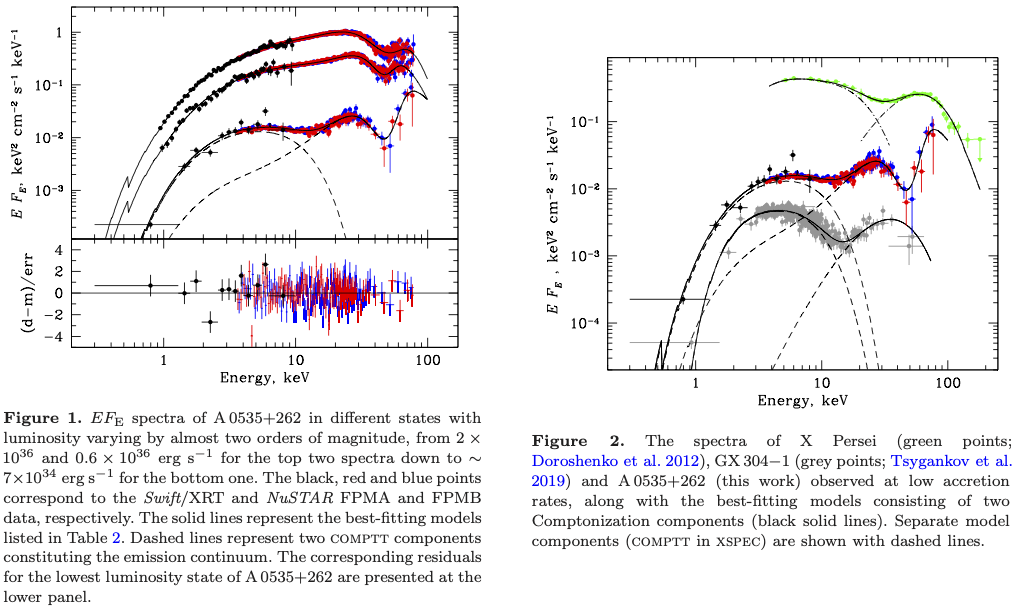
Deep NuSTAR observation of X-ray pulsar A 0535+262, performed at a very low
luminosity of ∼7×$10^{34}$ erg s$^{-1$, revealed the presence of two spectral
components. We argue that the high-energy component is associated with
cyclotron emission from recombination of electrons collisionally excited to the
upper Landau levels. The cyclotron line energy of Ecyc = 47.7 ± 0.8 keV was
measured at the luminosity of almost an order of magnitude lower than what was
achieved before. The data firmly exclude a positive correlation of the
cyclotron energy with the mass accretion rate in this source
May 14, 2019
Another nice, and unexpected
result in
collaboration with Turku collegues has just been published.
The X-ray pulsar GRO J1744-28 is a unique source that shows both pulsations and
type-II X-ray bursts, allowing studies of the interaction of the accretion disk
with the magnetosphere at huge mass-accretion rates exceeding 10$^{19}$ g
s${-1}$ during its super-Eddington outbursts. The magnetic field strength in
the source, B ≈ 5×10$^{11}$G, is known from the cyclotron absorption feature
discovered in the energy spectrum around 4.5 keV. Here, we have explored the
flux variability of the source in context of interaction of its magnetosphere
with the radiation-pressure dominated accretion disk. Specifically, we present
the results of the analysis of noise power density spectra (PDS) using the
observations of the source in 1996-1997 by the Rossi X-ray Timing Explorer
(RXTE). Accreting compact objects commonly exhibit a broken power-law PDS shape
with a break corresponding to the Keplerian orbital frequency of matter at the
innermost disk radius. The observed frequency of the break can thus be used to
estimate the size of the magnetosphere. We find, however, that the observed PDS
of GRO J1744-28 differs dramatically from the canonical shape. The observed
break frequency appears to be significantly higher than expected based on the
magnetic field estimated from the cyclotron line energy. We argue that these
observational facts can be attributed to the existence of the
radiation-pressure dominated region in the accretion disk at luminosities above
∼2×10$^{37}$ erg s$^{-1}$. We discuss a qualitative model for the PDS formation in such
disks, and show that its predictions are consistent with our observational
findings. The presence of the radiation-pressure dominated region can also
explain the observed weak luminosity dependence of the inner radius, and we
argue that the small inner radius can be explained by a quadrupole component
dominating the magnetic field of the neutron star.
Feb 13, 2019
Keeping connection with IKI collegues, we've just published a new paper
on a long-known, but mysterious X-ray pulsar.
We report on analysis of properties of the X-ray binary pulsar GRO J1750-27
based on X-ray (Chandra, Swift, and Fermi/GBM), and near-infrared (VVV and
UKIDSS surveys) observations. An accurate position of the source is determined
for the first time and used to identify its infrared counterpart. Based on the
VVV data we investigate the spectral energy distribution (SED) of the
companion, taking into account a non-standard absorption law in the source
direction. A comparison of this SED with those of known Be/X-ray binaries and
early-type stars has allowed us to estimate a lower distance limit to the
source at >12 kpc. An analysis of the observed spin-up torque during a giant
outburst in 2015 provides an independent distance estimate of 14-22 kpc, and
also allows to estimate the magnetic field on the surface of the neutron star
at B ≃ (3.5-4.5)×10$^{12}$ G. The latter value is in agreement with the possible
transition to the propeller regime, a strong hint for which was revealed by
Swift/XRT and Chandra. We conclude, that GRO J1750-27 is located far behind the
Galactic Centre, which makes it one of the furthest Galactic X-ray binaries
known.
Dec 21, 2018
Finally something new in X-ray pulsar astronomy!
Now X Persei is not alone anymore.
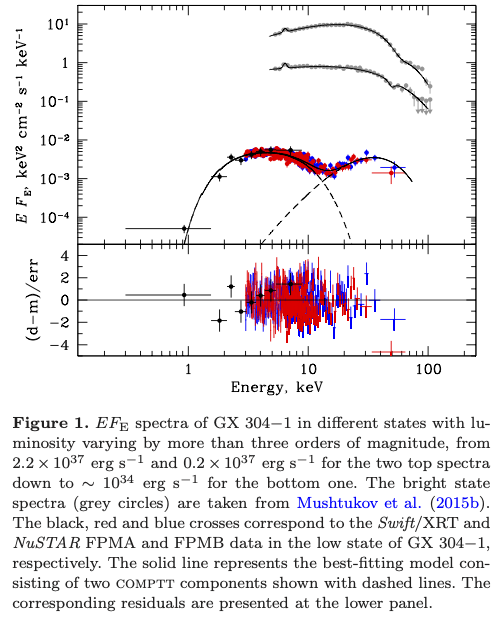
We report on the discovery of a dramatic change in the energy spectrum of the
X-ray pulsar GX 304-1 appearing at low luminosity. Particularly, we found that
the cut-off power-law spectrum typical for accreting pulsars, including GX
304-1 at higher luminosities of $L_X\sim10^{36-37}$ erg s$^{-1}$, transformed at lower
luminosity of $L_X\sim10^{34}$ erg s$^{-1}$ to a two-component spectrum peaking around 5
and 40 keV. We suggest that the observed transition corresponds to a change of
the dominant mechanism responsible for the deceleration of the accretion flow.
We argue that the accretion flow energy at low accretion rates is released in
the atmosphere of the neutron star, and the low-energy component in the source
spectrum corresponds to the thermal emission of the optically thick, heated
atmospheric layers. The most plausible explanations for the high-energy
component are either the cyclotron emission reprocessed by the magnetic Compton
scattering or the thermal radiation of deep atmospheric layers partly
Comptonized in the overheated upper layers. Alternative scenarios are also
discussed.
Dec 08, 2018
After lots of work by lots of people (including myself), we've finally managed to push a series of eXTP white papers to support the mission.
Observatory science with eXTP
Physics and astrophysics of strong magnetic field systems with eXTP
Dense matter with eXTP
The enhanced X-ray Timing and Polarimetry mission—eXTP
Sep 15, 2018
After a lot of work, me and Valery Sulemanov managed to get a large paper on intermediate polars out.
There are several interesting ideas inside, most notably to look both at energy and power density spectra which allowed very precise
mass measurements using X-ray data alone! Note that Valery made his model for post-shock region in intermediate polars publiciliy available.

The hardness of the X-ray spectra of intermediate polars (IPs) is determined
mainly by the white dwarf (WD) compactness (mass-radius ratio, M/R) and, thus,
hard X-ray spectra can be used to constrain the WD mass. An accurate mass
estimate requires the finite size of the WD magnetosphere R$m$ to be taken into
the account. We suggested to derive it either directly from the observed break
frequency in power spectrum of X-ray or optical light curves of a polar, or
assuming the corotation. Here we apply this method to all IPs observed by
NuSTAR (10 objects) and Swift/BAT (35 objects). For the dwarf nova GK Per, we
also observe a change of the break frequency with flux, which allows us to
constrain the dependence of the magnetosphere radius on the mass accretion
rate. For our analysis, we calculated an additional grid of two-parameter (M
and R$$/R) model spectra assuming a fixed, tall height of the accretion column
H${sh}$/R = 0.25, which is appropriate to determine WD masses in low mass accretion
IPs like EX Hya. Using the GaiaData Release 2, we obtain for the first time
reliable estimates of the mass accretion rate and the magnetic field strength
at the WD surface for a large fraction of objects in our sample. We find that
most IPs accrete at a rate of ∼10$^{-9}M\odot$ yr-1 and have magnetic fields in the
range 1-10 MG. The resulting WD mass average of our sample is 0.79±0.16$M_\odot$,
which is consistent with earlier estimates.








